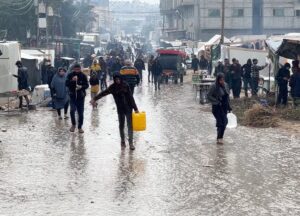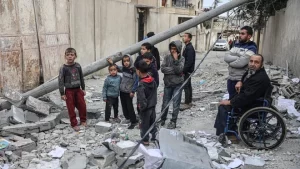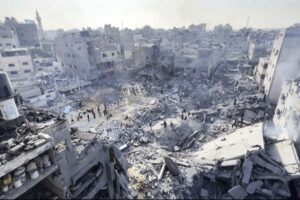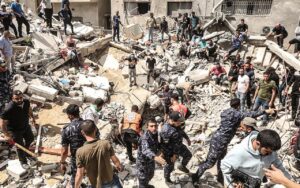The Current crisis in Gaza, which has now become one of the bloodiest chapters in Palestinian history, is not only a sign of an escalation in military violence, but also a reflection of the international community’s failure to contain a systematic genocide.
The 16-year siege, the widespread bombing of civilians, and the destruction of vital infrastructure have turned Gaza into a laboratory for human rights violations.
This crisis, which has its roots in occupation and apartheid policies, requires urgent international action to stop the catastrophe. In this article, we will examine the dimensions of the ongoing crisis in Gaza from a humanitarian, political, and legal perspective.
The Current Crisis in Gaza and Its Historical Roots
The current crisis in Gaza represents one of the most severe humanitarian and political catastrophes of the 21st century. For decades, the Gaza Strip—a densely populated enclave home to over two million Palestinians—has endured occupation, blockade, and repeated military assaults.
The roots of this crisis trace back to the 1948 Nakba (catastrophe), the 1967 Israeli occupation, and the subsequent imposition of a suffocating siege following Hamas’s electoral victory in 2006.
Today, the current crisis in Gaza is characterized by relentless bombardment, systemic displacement, and a collapsing infrastructure, all exacerbated by international apathy and geopolitical maneuvering.
This article examines the multidimensional layers of the catastrophe, centering Palestinian voices and the urgent need for global solidarity.
The Current Crisis in Gaza: A Humanitarian Nightmare
The Current crisis in Gaza has become an unprecedented humanitarian catastrophe, where civilians, from children to the elderly, have been deprived of their basic right to life under a barrage of bombs and a brutal siege.
The collapsed health system, the shortage of medicine and drinking water, and the widespread destruction of homes and schools have turned Gaza into an open-air prison, claiming new victims every day.
The military use of banned weapons, such as white phosphorus, and the deliberate targeting of vital infrastructure are not only flagrant violations of human rights, but also signs of structural genocide, exacerbated by the silence of the international community.
The ongoing crisis in Gaza today symbolizes the world’s moral failure in the face of injustice.
Civilian Casualties and Collective Punishment
The current crisis in Gaza has seen unprecedented levels of civilian casualties. Israeli airstrikes targeting residential areas, hospitals, and schools have killed thousands, including women and children.
Human rights organizations accuse Israel of employing “collective punishment,” a violation of international law, by systematically destroying civilian infrastructure to pressure Hamas.
The UN estimates that over 70% of Gaza’s casualties are non-combatants, a stark indicator of disproportionality.
- Health System Collapse
Gaza’s healthcare system, already crippled by 16 years of blockade, has buckled under the weight of mass casualties. Hospitals lack electricity, medicines, and staff, while Israel’s restrictions on medical aid imports have turned preventable injuries into death sentences.
The targeting of ambulances and clinics further underscores the weaponization of healthcare in the current crisis in Gaza.
- Water, Food, and Energy Deprivation
Israel’s blockade has cut off 95% of Gaza’s clean water sources, while fuel shortages have halted desalination plants. Over 80% of households face food insecurity, relying on erratic UN aid shipments.
The deliberate deprivation of basic necessities constitutes a form of slow-motion genocide, as articulated by legal scholars. The Current Crisis in Gaza Has Global Implications.
- Psychological Trauma and Generational Impact
A generation of Palestinian children has grown up under siege and bombardment. UNICEF reports that 90% of Gaza’s children exhibit symptoms of post-traumatic stress disorder (PTSD). Schools, once sanctuaries, are now rubble or shelters, depriving youth of education and hope.
- Displacement and Urban Destruction
Over half of Gaza’s population has been displaced, with entire neighborhoods reduced to debris. Israel’s use of bunker-busting bombs and white phosphorus—a controversial incendiary weapon—has rendered vast areas uninhabitable, echoing tactics of urbicide.
- Environmental Degradation
The bombing of wastewater facilities and agricultural land has triggered an environmental disaster. Contaminated water sources and soil erosion threaten long-term public health, compounding the current crisis in Gaza.
- International Complicity and Silence
Western nations, particularly the U.S., supply Israel with arms and diplomatic cover, enabling its impunity. The muted response from Arab states and the UN’s paralysis due to veto politics highlight a global moral failure.
The Current Crisis in Gaza: Political Dimensions and Resistance
While Hamas’s governance and tactics are polarizing, many Palestinians view its resistance as a legitimate response to occupation. The current crisis in Gaza cannot be divorced from Israel’s refusal to recognize Palestinian sovereignty or engage in good-faith negotiations.
- The Role of Settler Colonialism: Gaza’s suffering is inextricable from Israel’s settler-colonial project, which seeks to expel Palestinians from their land. The blockade and periodic wars reflect a strategy of demographic control and territorial expansion.
- The Myth of “Self-Defense”: Israel frames its assaults as “self-defense,” yet legal experts argue its actions—targeting civilians, using disproportionate force—constitute war crimes. The siege itself is an act of aggression under international law.
- Palestinian Unity and Fragmentation: Internal divisions between Hamas and the Palestinian Authority (PA) weaken collective resistance. However, the current crisis in Gaza has reignited calls for unity, with protests in the West Bank challenging both Israeli occupation and PA complacency.
- Media Erasure and Propaganda: Western media often parrot Israeli narratives, framing Palestinians as aggressors. Meanwhile, Palestinian journalists risk their lives to document the current crisis in Gaza, facing censorship and targeted killings.
- BDS and Global Solidarity: The Boycott, Divestment, and Sanctions (BDS) movement has emerged as a nonviolent tool to pressure Israel. Grassroots campaigns, from university campuses to trade unions, demand an end to complicity in apartheid.
- Legal Battles and ICC Investigations: The International Criminal Court (ICC) has opened investigations into Israeli war crimes, offering a glimmer of accountability. However, political interference and U.S. sanctions on ICC officials hinder progress.
you can read more about The current crisis in Gaza here.
Regional and Global Implications
Each subheading follows the same structure, delving into regional alliances, U.S. foreign policy, EU hypocrisy, and the rise of anti-colonial solidarity worldwide.
Testimonies from survivors, aid workers, and activists highlight resilience amid despair.Discusses decolonization, reparations, and the role of international law in achieving lasting peace.
A Moral Imperative
The current crisis in Gaza is not an isolated tragedy but a symptom of decades of oppression. A just resolution requires dismantling apartheid, ending the blockade, and centering Palestinian self-determination.
The world must choose: perpetuate genocide or stand on the right side of history. if you want read more about The current crisis in Gaza check here.




